MATH 413 [513] (PHILLIPS) SOLUTIONS TO HOMEWORK 1
(Here, in addition to the fleld
Similarly, if rx 2 Q, then x = (rx)=r 2 Q.
Generally, a \solution" is something that would be acceptable if turned in in the
form presented here, although the solutions given are often close to minimal in this
respect. A \solution (sketch)" is too sketchy to be considered a complete solution
if turned in; varying amounts of detail would need to be fllled in.
Problem 1.1: If r 2 Q n f0g and x 2 R n Q, prove that r + x; rx 62 Q.
Solution: We prove this by contradiction. Let r 2 Qnf0g, and suppose that r +x 2
Q. Then, using the fleld properties of both R and Q, we have x = (r + x)¡ r 2 Q.
Thus x 62 Q implies r + x 62 Q.
properties of R and Q, we use r 6= 0.) Thus x 62 Q implies rx 62 Q.
Problem 1.2: Prove that there is no x 2 Q such that x2 = 12.
Solution: We prove this by contradiction. Suppose there is x 2 Q such that
x2 = 12. Write x = m
n in lowest terms. Then x2 = 12 implies that m2 = 12n2.
Since 3 divides 12n2, it follows that 3 divides m2. Since 3 is prime (and by unique
factorization in Z), it follows that 3 divides m. Therefore 32 divides m2 = 12n2.
Since 32 does not divide 12, using again unique factorization in Z and the fact that
3 is prime, it follows that 3 divides n. We have proved that 3 divides both m and
n, contradicting the assumption that the fraction m
Alternate solution (Sketch): If x 2 Q satisfles x2 = 12, then x
¢2 = 3. Now prove that there is no y 2 Q such that y2 = 3 by repeating the
¡
x
2
proof that
Problem 1.5: Let A ‰ R be nonempty and bounded below. Set ¡A = f¡a: a 2
Ag. Prove that inf(A) = ¡ sup(¡A).
Solution: First note that ¡A is nonempty and bounded above. Indeed, A contains
some element x, and then ¡x 2 A; moreover, A has a lower bound m, and ¡m is
an upper bound for ¡A.
We now know that b = sup(¡A) exists. We show that ¡b = inf(A). That ¡b is
a lower bound for A is immediate from the fact that b is an upper bound for ¡A.
To show that ¡b is the greatest lower bound, we let c > ¡b and prove that c is not
a lower bound for A. Now ¡c < b, so ¡c is not an upper bound for ¡A. So there
exists x 2 ¡A such that x > ¡c. Then ¡x 2 A and ¡x < c. So c is not a lower
bound for A.
Problem 1.6: Let b 2 R with b > 1, flxed throughout the problem.
Comment: We will assume known that the function n 7! bn, from Z to R, is
strictly increasing, that is, that for m; n 2 Z, we have bm < bn if and only if
m < n. Similarly, we take as known that x 7! xn is strictly increasing when n is
p
2 62 Q.
n is in lowest terms.
2 is in Q and satisfles
Date: 1 October 2001.
1
�
2
MATH 413 [513] (PHILLIPS) SOLUTIONS TO HOMEWORK 1
an integer with n > 0. We will also assume that the usual laws of exponents are
known to hold when the exponents are integers. We can’t assume anything about
fractional exponents, except for Theorem 1.21 of the book and its corollary, because
the context makes it clear that we are to assume fractional powers have not yet
been deflned.
(a) Let m; n; p; q 2 Z, with n > 0 and q > 0. Prove that if m
n = p
q , then
(bm)1=n = (bp)1=q.
Solution: By the uniqueness part of Theorem 1.21 of the book, applied to the
positive integer nq, it su–ces to show that
inq
h
inq
(bp)1=q
h
Now the deflnition in Theorem 1.21 implies that
h
=
:
iq
= bp:
(bp)1=q
(bm)1=n
inq
hh
= bm and
iniq
h
Therefore, using the laws of integer exponents and the equation mq = np, we get
h
(bm)1=n
in
(bm)1=n
=
(bm)1=n
= bnp = (bp)n =
(bp)1=q
iqin
hh
= (bm)q = bmq
h
(bp)1=q
inq
;
=
as desired.
This deflnes br for all r 2 Q.
By Part (a), it makes sense to deflne bm=n = (bm)1=n for m; n 2 Z with n > 0.
(b) Prove that br+s = brbs for r; s 2 Q.
Solution: Choose m; n; p; q 2 Z, with n > 0 and q > 0, such that r = m
s = p
applied to the positive integer nq, it su–ces to show that
n and
. By the uniqueness part of Theorem 1.21 of the book,
q . Then r + s = mq+np
nq
h
inq
h
b(mq+np)=(nq)
=
inq
:
(bm)1=n(bp)1=q
‚nq
i1=(nq)
Directly from the deflnitions, we can write
h
inq
•h
b(mq+np)=(nq)
=
b(mq+np)
= b(mq+np):
Using the laws of integer exponents and the deflnitions for rational exponents, we
can rewrite the right hand side as
inq
hh
iniq hh
iqin
(bm)1=n(bp)1=q
=
(bm)1=n
(bp)1=q
= (bm)q(bp)n = b(mq+np):
h
This proves the required equation, and hence the result.
(c) For x 2 R, deflne
B(x) = fbr : r 2 Q \ (¡1; x]g:
Prove that if r 2 Q, then br = sup(B(r)).
Solution: The main point is to show that if r; s 2 Q with r < s, then br < bs.
Choose m; n; p; q 2 Z, with n > 0 and q > 0, such that r = m
q . Then
n and s = p
�
MATH 413 [513] (PHILLIPS) SOLUTIONS TO HOMEWORK 1
3
also r = mq
nq and s = np
nq , with nq > 0, so
br = (bmq)1=(nq)
and bs = (bnp)1=(nq):
Now mq < np because r < s. Therefore, using the deflnition of c1=(nq),
(br)nq = bmq < bnp = (bs)nq:
Since x 7! xnq is strictly increasing, this implies that br < bs.
Now we can prove that if r 2 Q then br = sup(B(r)). By the above, if s 2 Q
and s • r, then bs • br. This implies that br is an upper bound for B(r). Since
br 2 B(r), obviously no number smaller than br can be an upper bound for B(r).
So br = sup(B(r)).
We now deflne bx = sup(B(x)) for every x 2 R. We need to show that B(x)
is nonempty and bounded above. To show it is nonempty, choose (using the
Archimedean property) some k 2 Z with k < x; then bk 2 B(x). To show it
is bounded above, similarly choose some k 2 Z with k > x. If r 2 Q \ (¡1; x],
then br 2 B(k) so that br • bk by Part (c). Thus bk is an upper bound for B(x).
This shows that the deflnition makes sense, and Part (c) shows it is consistent with
our earlier deflnition when r 2 Q.
(d) Prove that bx+y = bxby for all x; y 2 R.
In order to do this, we are going to need to replace the set B(x) above by the
Solution:
set
B0(x) = fbr : r 2 Q \ (¡1; x)g
We show that the replacement is possible via some lemmas.
(that is, we require r < x rather than r • x) in the deflnition of bx. (If you are
skeptical, read the main part of the solution flrst to see how this is used.)
Lemma 1. If x 2 [0;1) and n 2 Z satisfles n ‚ 0, then (1 + x)n ‚ 1 + nx.
Proof: The proof is by induction on n. The statement is obvious for n = 0. So
assume it holds for some n. Then, since x ‚ 0,
(1 + x)n+1 = (1 + x)n(1 + x) ‚ (1 + nx)(1 + x)
= 1 + (n + 1)x + nx2 ‚ 1 + (n + 1)x:
This proves the result for n + 1.
Lemma 2. inffb1=n : n 2 Ng = 1. (Recall that b > 1 and N = f1; 2; 3; : : :g.)
Proof: Clearly 1 is a lower bound. (Indeed, (b1=n)n = b > 1 = 1n, so b1=n > 1.) We
show that 1 + x is not a lower bound when x > 0. If 1 + x were a lower bound, then
1 + x • b1=n would imply (1 + x)n • (b1=n)n = b for all n 2 N. By Lemma 1, we
would get 1 + nx • b for all n 2 N, which contradicts the Archimedean property
when x > 0.
Lemma 3. supfb¡1=n : n 2 Ng = 1.
Proof: Part (b) shows that b¡1=nb1=n = b0 = 1, whence b¡1=n = (b1=n)¡1. Since
all numbers b¡1=n are strictly positive, it now follows from Lemma 2 that 1 is an
upper bound. Suppose x < 1 is an upper bound. Then x¡1 is a lower bound for
�
4
MATH 413 [513] (PHILLIPS) SOLUTIONS TO HOMEWORK 1
fb1=n : n 2 Ng. Since x¡1 > 1, this contradicts Lemma 2. Thus supfb¡1=n : n 2
Ng = 1, as claimed.
Lemma 4. bx = sup(B0(x)) for x 2 R.
If x 2 Q,
Proof: If x 62 Q, then B0(x) = B(x), so there is nothing to prove.
then at least B0(x) ‰ B(x), so bx ‚ sup(B0(x)). Moreover, Part (b) shows that
bx¡1=n = bxb¡1=n for n 2 N. The numbers bx¡1=n are all in B0(x), and
supfbxb¡1=n : n 2 Ng = bx supfb¡1=n : n 2 Ng
because bx > 0, so using Lemma 3 in the last step gives
sup(B0(x)) ‚ supfbx¡1=n : n 2 Ng = bx supfb¡1=n : n 2 Ng = bx:
Now we can prove the formula bx+y = bxby. We start by showing that bx+y •
bxby, which we do by showing that bxby is an upper bound for B0(x + y). Thus let
r 2 Q satisfy r < x+ y. Then there are s0; t0 2 R such that r = s0 + t0 and s0 < x,
t0 < y. Choose s; t 2 Q such that s0 < s < x and t0 < t < y. Then r < s + t, so
br < bs+t = bsbt • bxby. This shows that bxby is an upper bound for B0(x + y).
(Note that this does not work using B(x + y). If x + y 2 Q but x; y 62 Q, then
bx+y 2 B(x + y), but it is not possible to flnd s and t with bs 2 B(x), bt 2 B(y),
and bsbt = bx+y.)
We now prove the reverse inequality. Suppose it fails, that is, bx+y < bxby. Then
The left hand side is thus not an upper bound for B0(x), so there exists s 2 Q with
s < x and
bx+y
by
< bx:
It follows that
bx+y
by
bx+y
< bs:
< by:
bs
Repeating the argument, there is t 2 Q with t < y such that
Therefore
bx+y
bs
< bt:
bx+y < bsbt = bs+t
(using Part (b)). But bs+t 2 B0(x + y) because s + t 2 Q and s + t < x + y, so this
is a contradiction. Therefore bx+y • bxby.
Problem 1.9: Deflne a relation on C by w < z if and only if either Re(w) < Re(z)
or both Re(w) = Re(z) and Im(w) < Im(z). (For z 2 C, the expressions Re(z)
and Im(z) denote the real and imaginary parts of z.) Prove that this makes C an
ordered set. Does this order have the least upper bound property?
Solution: We verify the two conditions in the deflnition of an order. For the flrst,
let w; z 2 C. There are three cases.
Case 1: Re(w) < Re(z). Then w < z, but w = z and w > z are both false.
Case 2: Re(w) > Re(z). Then w > z, but w = z and w < z are both false.
�
MATH 413 [513] (PHILLIPS) SOLUTIONS TO HOMEWORK 1
5
Case 3: Re(w) = Re(z). This case has three subcases.
Case 3.1: Im(w) < Im(z). Then w < z, but w = z and w > z are both false.
Case 3.2: Im(w) > Im(z). Then w > z, but w = z and w < z are both false.
Case 3.3: Im(w) = Im(z). Then w = z, but w > z and w < z are both false.
These cases exhaust all possibilities, and in each of them exactly one of w < z,
w = z, and w > z is true, as desired.
Now we prove transitivity. Let s < w and w < z.
If either Re(s) < Re(w)
or Re(w) < Re(z), then clearly Re(s) < Re(z), so s < z.
If Re(s) = Re(w)
and Re(w) = Re(z), then the deflnition of the order requires Im(s) < Im(w) and
Im(w) < Im(z). We thus have Re(s) = Re(z) and Im(s) < Im(z), so s < z by
deflnition.
It remains to answer the last question. We show that this order does not have
the least upper bound property. Let S = fz 2 C: Re(z) < 0g. Then S 6= ? because
¡1 2 S, and S is bounded above because 1 is an upper bound for S.
We show that S does not have a least upper bound by showing that if w is an
upper bound for S, then there is a smaller upper bound. First, by the deflnition of
the order it is clear that Re(w) is an upper bound for
fRe(z): z 2 Sg = (¡1; 0):
Therefore Re(w) ‚ 0. Moreover, every u 2 C with Re(u) ‚ 0 is in fact an upper
bound for S. In particular, if w is an upper bound for S, then w ¡ i < w and has
the same real part, so is a smaller upper bound.
Note: A related argument shows that the set T = fz 2 C: Re(z) • 0g also has
no least upper bound. One shows that w is an upper bound for T if and only if
Re(w) > 0.
Problem 1.13: Prove that if x; y 2 C, then jjxj ¡ jyjj • jx ¡ yj.
Solution: The desired inequality is equivalent to
jxj ¡ jyj • jx ¡ yj and jyj ¡ jxj • jx ¡ yj:
We prove the flrst; the second follows by exchanging x and y.
Set z = x ¡ y. Then x = y + z. The triangle inequality gives jxj • jyj + jzj.
Substituting the deflnition of z and subtracting jyj from both sides gives the result.
Problem 1.17: Prove that if x; y 2 Rn, then
kx + yk2 + kx ¡ yk2 = 2kxk2 + 2kyk2:
Interpret this result geometrically in terms of parallelograms.
Solution: Using the deflnition of the norm in terms of scalar products, we have:
kx + yk2 + kx ¡ yk2 = hx + y; x + yi + hx ¡ y; x ¡ yi
= hx; xi + hx; yi + hy; xi + hy; yi
+ hx; xi ¡ hx; yi ¡ hy; xi + hy; yi
= 2hx; xi + 2hy; yi = 2kxk2 + 2kyk2:
The interpretation is that 0; x; y; x + y are the vertices of a parallelogram, and
that kx + yk and kx¡ yk are the lengths of its diagonals while kxk and kyk are each
�
6
MATH 413 [513] (PHILLIPS) SOLUTIONS TO HOMEWORK 1
Note: One can do the proof directly in terms of the formula kxk2 =
the lengths of two opposite sides. Therefore the sum of the squares of the lengths
Pn
of the diagonals is equal to the sum of the squares of the lengths of the sides.
k=1 jxkj2.
The steps are all the same, but it is more complicated to write.
It is also less
general, since the argument above applies to any norm that comes from a scalar
product.
�
MATH 413 [513] (PHILLIPS) SOLUTIONS TO HOMEWORK 2
Generally, a \solution" is something that would be acceptable if turned in in the
form presented here, although the solutions given are often close to minimal in this
respect. A \solution (sketch)" is too sketchy to be considered a complete solution
if turned in; varying amounts of detail would need to be fllled in.
S1
Problem 2.2: Prove that the set of algebraic numbers is countable.
Solution (sketch): For each flxed integer n ‚ 0, the set Pn of all polynomials
with integer coe–cients and degree at most n is countable, since it has the same
cardinality as the set f(a0; : : : ; an): ai 2 Ng = Nn+1. The set of all polynomials
n=0 Pn, which is a countable union of countable sets
with integer coe–cients is
and so countable. Each polynomial has only flnitely many roots (at most n for
degree n), so the set of all possible roots of all polynomials with integer coe–cients
is a countable union of flnite sets, hence countable.
Problem 2.3: Prove that there exist real numbers which are not algebraic.
Solution (Sketch): This follows from Problem 2.2, since R is not countable.
Problem 2.4: Is R n Q countable?
Solution (Sketch): No. Q is countable and R is not countable.
Problem 2.5: Construct a bounded subset of R with exactly 3 limit points.
Solution (Sketch): For example, use
1 + 1
“
n : n 2 N
n : n 2 N
n : n 2 N
“ ['
“ ['
'
1
2 + 1
:
0
= E0. Is (E0)0 always equal to E0?
Problem 2.6: Let E0 denote the set of limit points of E. Prove that E0 is closed.
Prove that E
Solution (Sketch): Proving that E0 is closed is equivalent to proving that (E0)0 ‰
E0. So let x 2 (E0)0 and let " > 0. Choose y 2 E0 \ (N"(x) n fxg). Choose
– = min(d(x; y); " ¡ d(x; y)) > 0. Choose z 2 E \ (N–(y) n fyg). The triangle
inequality ensures z 6= x and z 2 N"(x). This shows x is a limit point of E.
Here is a difierent way to prove that (E0)0 ‰ E0. Let x 2 (E0)0 and " > 0.
Choose y 2 E0 \ (N"=2(x) n fxg). By Theorem 2.20 of Rudin, there are inflnitely
many points in E \ (N"=2(y) n fyg). In particular there is z 2 E \ (N"=2(y) n fyg)
with z 6= x. Now z 2 E \ (N"(x) n fxg).
0 ‰ E0. We flrst claim that if A and B
are any subsets of X, then (A [ B)0 ‰ A0 [ B0. The fastest way to do this is to
assume that x 2 (A [ B)0 but x 62 A0, and to show that x 2 B0. Accordingly, let
x 2 (A [ B)0 n A0. Since x 62 A0, there is "0 > 0 such that N"0(x) \ A contains no
= E0, it su–ces to prove E
To prove E
0
Date: 8 October 2001.
1
�
2
MATH 413 [513] (PHILLIPS) SOLUTIONS TO HOMEWORK 2
points except possibly x itself. Now let " > 0; we show that N"(x) \ B contains at
least one point difierent from x. Let r = min("; "0) > 0. Because x 2 (A [ B)0,
there is y 2 Nr(x)\(A[ B) with y 6= x. Then y 62 A because r • "0. So necessarily
y 2 B, and thus y is a point difierent from x and in Nr(x) \ B. This shows that
x 2 B0, and completes the proof that (A [ B)0 ‰ A0 [ B0.
To prove E
0 ‰ E0, we now observe that
0
E
= (E [ E0
0 ‰ E0 [ (E0
)
0 ‰ E0 [ E0
)
= E0:
An alternate proof that E
the proofs above that (E0)0 ‰ E0.
For the third part, the answer is no. Take
0 ‰ E0 can be obtained by slightly modifying either of
E = f0g ['
“
n : n 2 N
1
:
Then E0 = f0g and (E0)0 = ?. (Of course, you must prove these facts.)
Problem 2.8: If E ‰ R2 is open, is every point of E a limit point of E? What if
E is closed instead of open?
Solution (Sketch): Every point of an open set E ‰ R2 is a limit point of E. Indeed,
if x 2 E, then there is " > 0 such that N"(x) ‰ E, and it is easy to show that x is
a limit point of N"(x).
(Warning: This is not true in a general metric space.)
Not every point of a closed set need be a limit point. Take E = f(0; 0)g, which
has no limit points.
Problem 2.9: Let E– denote the set of interior points of a set E, that is, the
interior of E.
Solution (sketch): First show that X n E– ‰ X n E. If x 62 E, then clearly x 2
X n E. Otherwise, consider x 2 E n E–. Rearranging the statement that x fails to
be an interior point of E, and noting that x itself is not in X n E, one gets exactly
the statement that x is a limit point of X n E.
Now show that X n E ‰ X n E–. If x 2 X n E, then clearly x 62 E–. If x 62 X n E
but x is a limit point of X n E, then one simply rearranges the deflnition of a limit
point to show that x is not an interior point of E.
¡
¢–
(e) Prove or disprove:
E
= E.
(a) Prove that E– is open.
Solution (sketch): If x 2 E–, then there is " > 0 such that N"(x) ‰ E. Since N"(x)
is open, every point in N"(x) is an interior point of N"(x), hence of the bigger set
E. So N"(x) 2 E–.
(b) Prove that E is open if and only if E– = E.
Solution: If E is open, then E = E– by the deflnition of E–. If E = E–, then E is
open by Part (a).
(c) If G is open and G ‰ E, prove that G ‰ E–.
Solution (sketch): If x 2 G ‰ E and G is open, then x is an interior point of G.
Therefore x is an interior point of the bigger set E. So x 2 E–.
(d) Prove that X n E– = X n E.
�
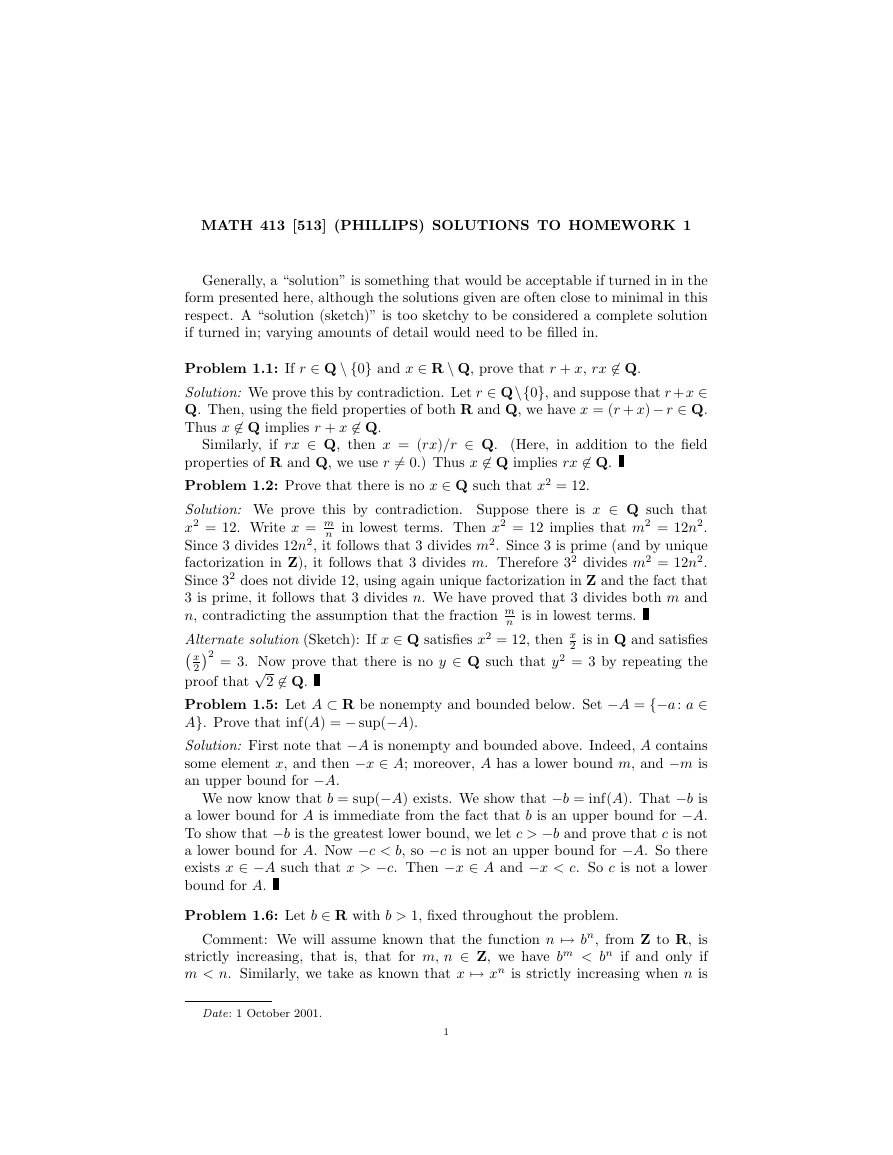
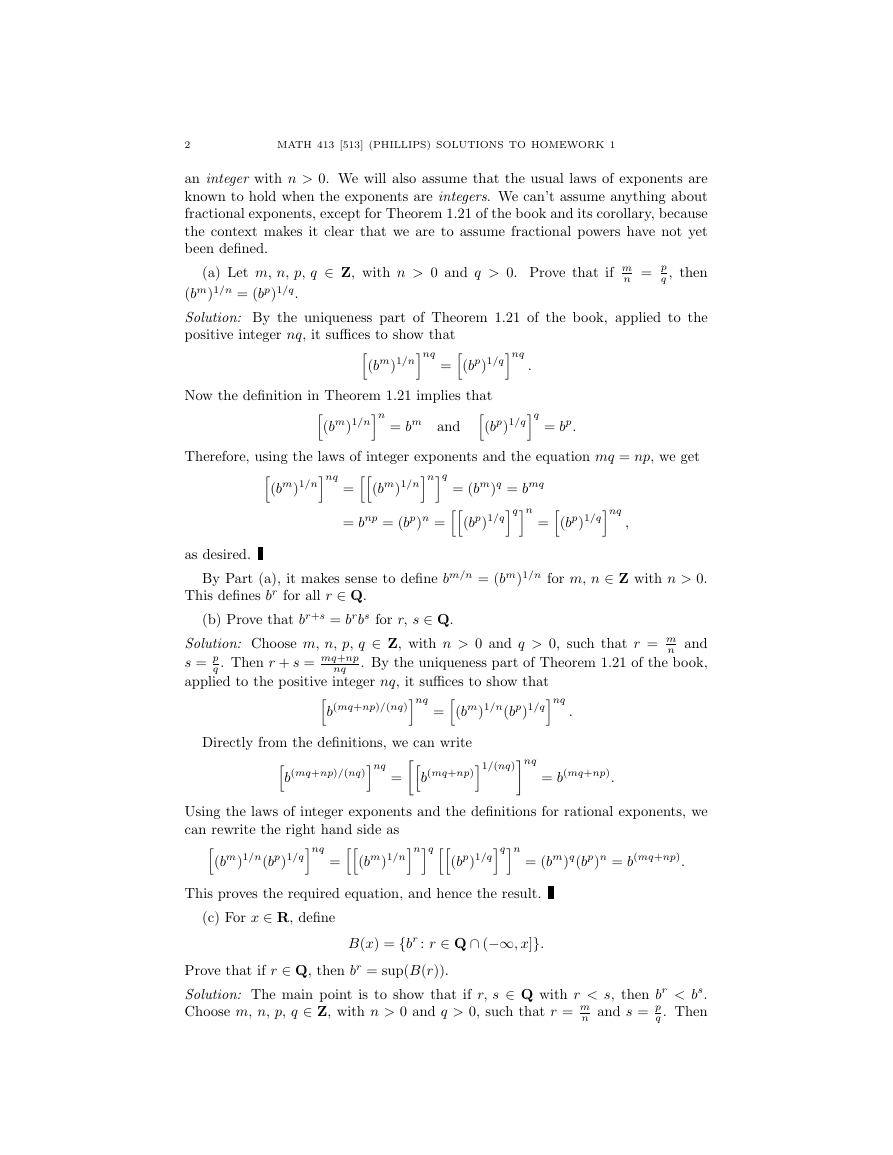

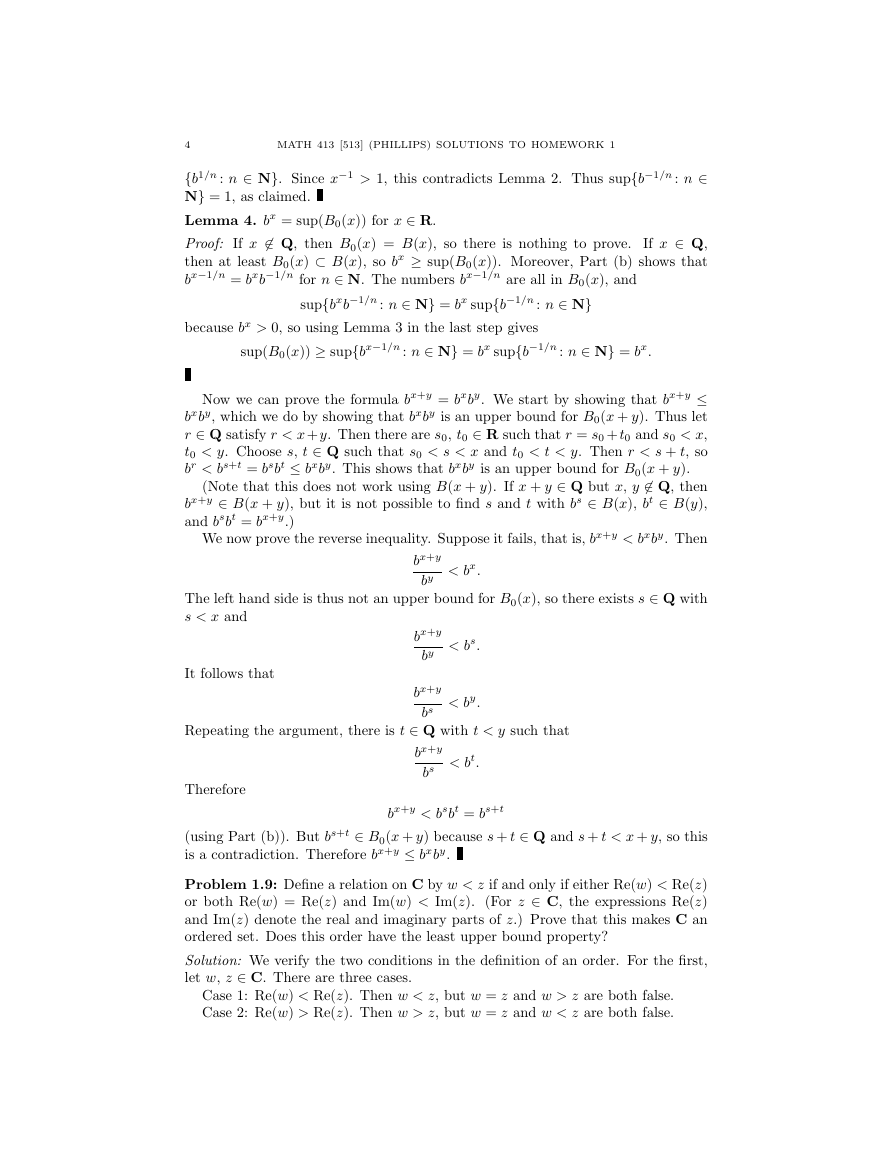
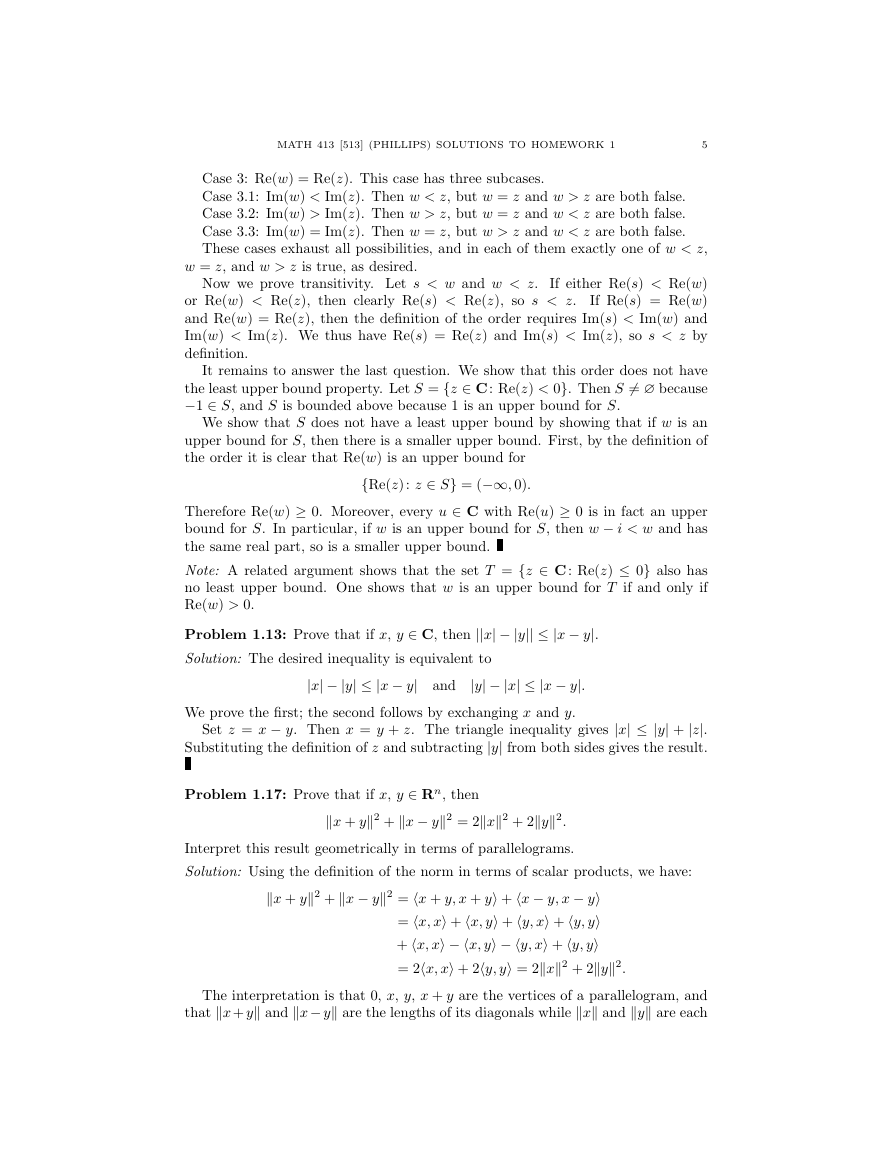
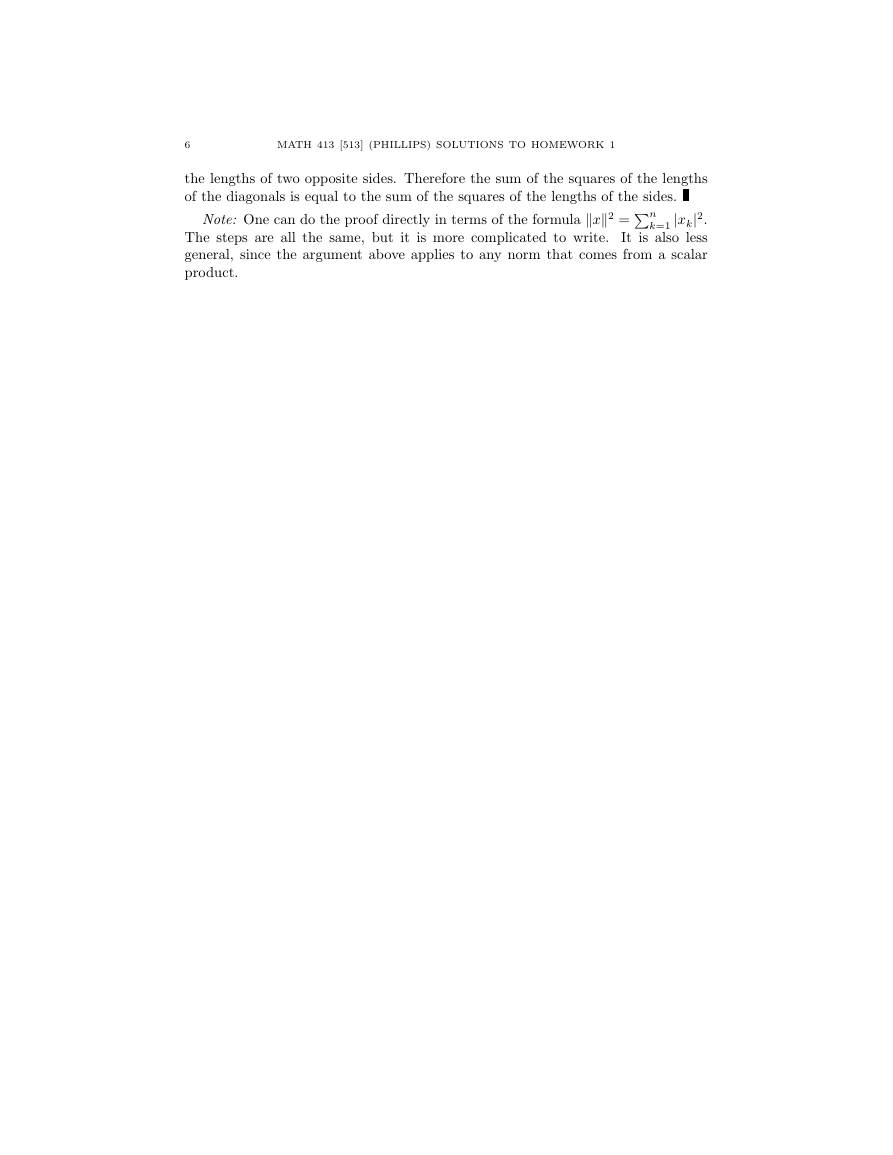
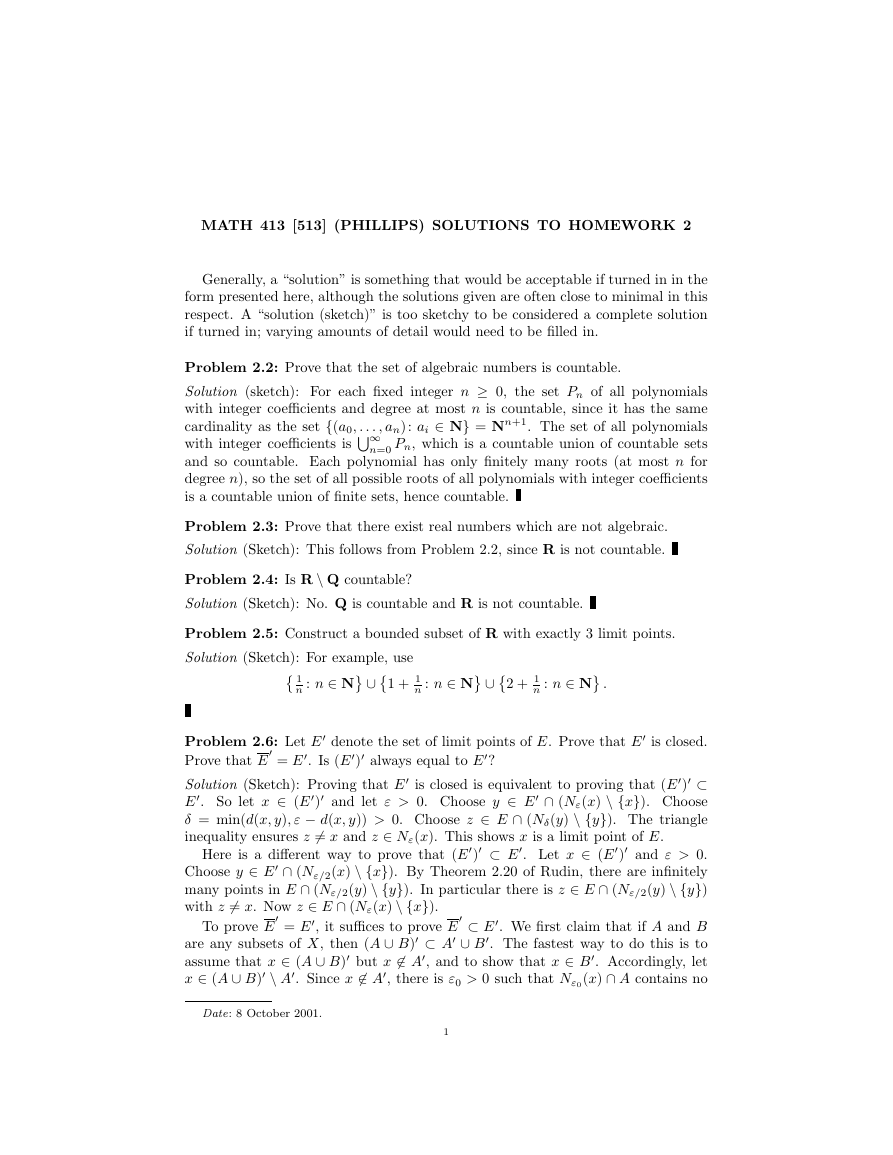
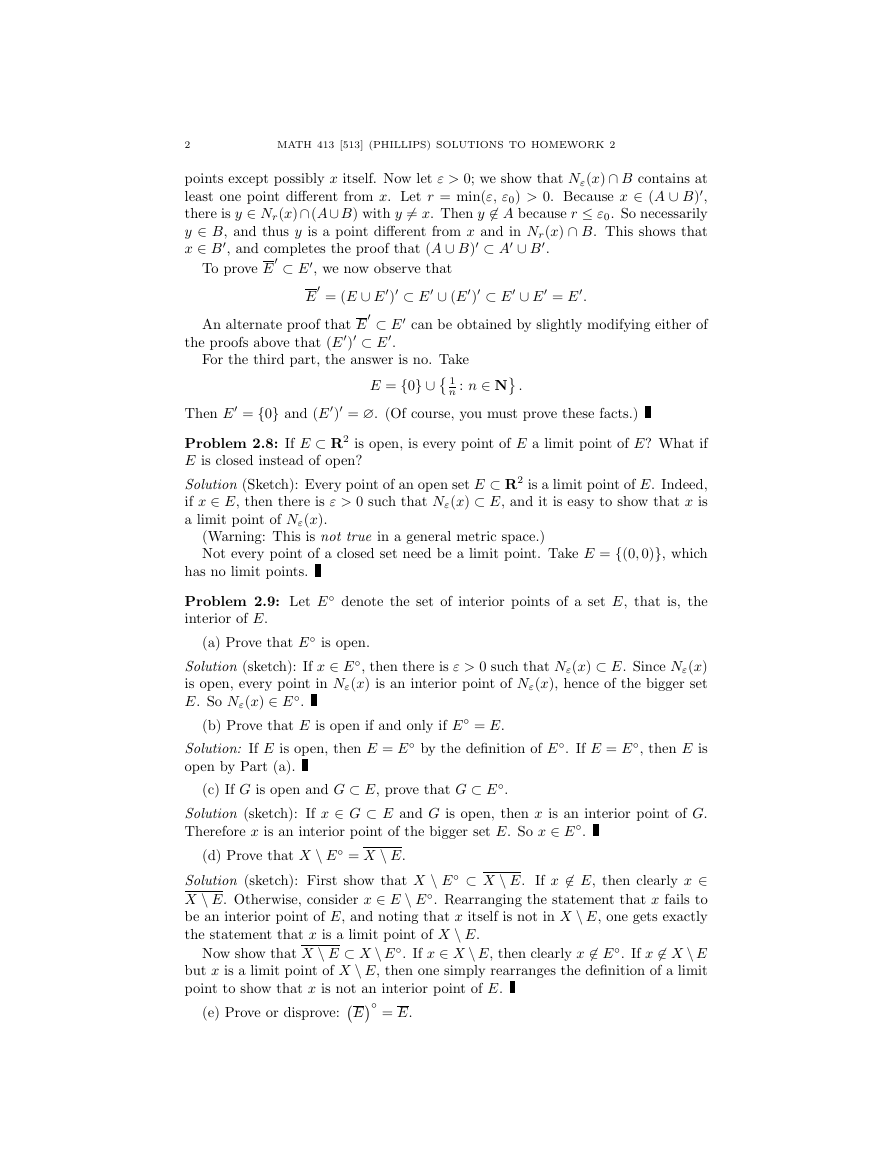








 2023年江西萍乡中考道德与法治真题及答案.doc
2023年江西萍乡中考道德与法治真题及答案.doc 2012年重庆南川中考生物真题及答案.doc
2012年重庆南川中考生物真题及答案.doc 2013年江西师范大学地理学综合及文艺理论基础考研真题.doc
2013年江西师范大学地理学综合及文艺理论基础考研真题.doc 2020年四川甘孜小升初语文真题及答案I卷.doc
2020年四川甘孜小升初语文真题及答案I卷.doc 2020年注册岩土工程师专业基础考试真题及答案.doc
2020年注册岩土工程师专业基础考试真题及答案.doc 2023-2024学年福建省厦门市九年级上学期数学月考试题及答案.doc
2023-2024学年福建省厦门市九年级上学期数学月考试题及答案.doc 2021-2022学年辽宁省沈阳市大东区九年级上学期语文期末试题及答案.doc
2021-2022学年辽宁省沈阳市大东区九年级上学期语文期末试题及答案.doc 2022-2023学年北京东城区初三第一学期物理期末试卷及答案.doc
2022-2023学年北京东城区初三第一学期物理期末试卷及答案.doc 2018上半年江西教师资格初中地理学科知识与教学能力真题及答案.doc
2018上半年江西教师资格初中地理学科知识与教学能力真题及答案.doc 2012年河北国家公务员申论考试真题及答案-省级.doc
2012年河北国家公务员申论考试真题及答案-省级.doc 2020-2021学年江苏省扬州市江都区邵樊片九年级上学期数学第一次质量检测试题及答案.doc
2020-2021学年江苏省扬州市江都区邵樊片九年级上学期数学第一次质量检测试题及答案.doc 2022下半年黑龙江教师资格证中学综合素质真题及答案.doc
2022下半年黑龙江教师资格证中学综合素质真题及答案.doc